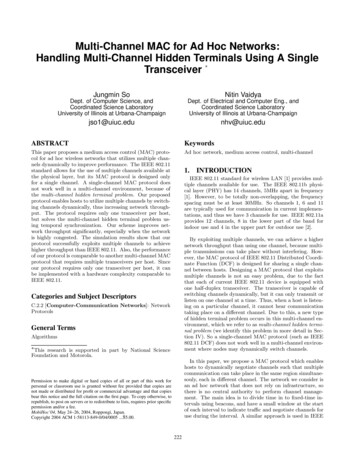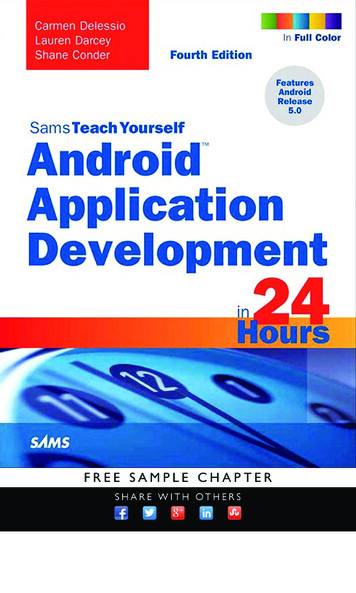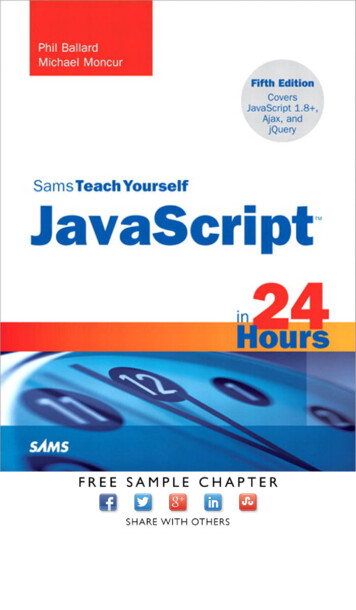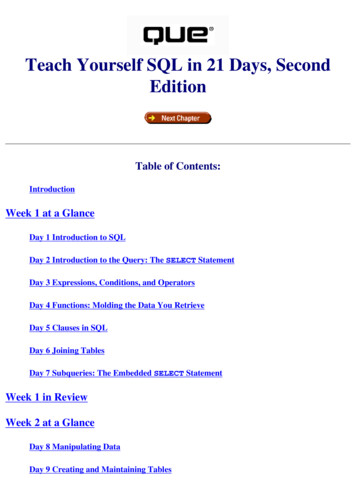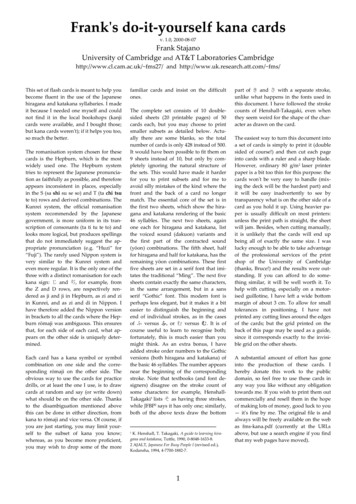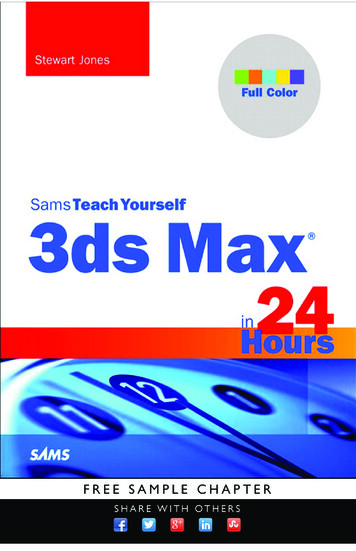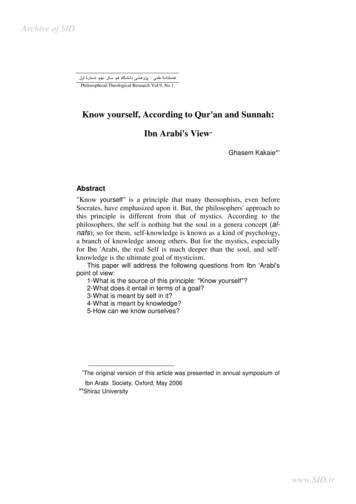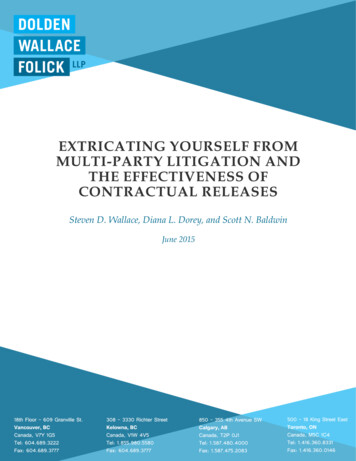
Transcription
EXTRICATING YOURSELF FROMMULTI-PARTY LITIGATION ANDTHE EFFECTIVENESS OFCONTRACTUAL RELEASESSteven D. Wallace, Diana L. Dorey, and Scott N. BaldwinJune 2015 Dolden Wallace Folick LLP1
CONTACT LAWYERSteven WallaceDiana DoreyScott BLE OF CONTENTSI.INTRODUCTION .3II.PARTIAL SETTLEMENT AGREEMENTS .3A.Pierringer Agreements .3B.Mary Carter Agreements .5C.Terms For Non Settling Parties .7D.Procedural Pitfalls .8E.Distinctions Between Canadian Jurisdictions .10F.Disclosure Of The Agreement .10G.Law Reform.111.Law Commission of Ontario – Joint and SeveralLiability Final Report 2011 .112.Alberta Institute of Law Research and Reform –Report No. 31 Contributory Negligence andConcurrent Wrongdoers – April, 1979 .123.Manitoba Law Reform Commission- ContributoryFault : The Tortfeasors and Contributory NegligenceAct September 2013. .124.British Columbia Law Institute – Report onContribution and Settlement under the NegligenceAct – December 2013 .12III.WAYS IN WHICH RELEASES ARE SET ASIDE .13A.Incorrect Terms (Non Est Factum) .13B.Mutual or Unilateral Mistake of Fact .14C.Misrepresentation .15D.Unconscionable Bargain.15IV.STEPS TO AVOID A RELEASE BEING SET ASIDE .171 Dolden Wallace Folick LLP
V.CONCLUSION .18VI.EXAMPLE LANGUAGE.18A.Appendix “A” - Sample BC Ferry Agreement .20B.Appendix “B” - Sample Mary Carter Agreement .26 Dolden Wallace Folick LLP2
EXTRICATING YOURSELF FROM MULTI-PARTY LITIGATION AND THEEFFECTIVENESS OF CONTRACTUAL RELEASESI.INTRODUCTIONThis paper describes two common types of partial settlement agreement, which areinsurers can use to extricate their insureds from multiparty litigation where not alllitigants are motivated to settle: Pierringer and Mary Carter Agreements. We alsoanswer several common technical questions regarding the implementation of Pierringerand Mary Carter Agreements, illustrate some of the procedural pitfalls which haveemerged from the caselaw, and explain how these agreements are treated by the Courtsin different jurisdictions in Canada.The paper also comments on recent issues discussed by law reformers across Canada asthey relate to joint and several liability. Law reform in the area of joint and severalliability could greatly impact the frequency with which Pierringer Agreements areutilized in multiparty litigation because such agreements sever liability, which mayspur plaintiffs to accept partial settlements. For example, if Ontario municipalgovernments were no longer to be held jointly liable for negligence claims, it is likelythat municipalities would be able to negotiate Pierringer Agreements far morefrequently and on more favourable terms.The second part of this paper deals with releases, which are often important elements ofsettlement agreements. We describe ways in which releases have been set aside by theCanadian Courts, and suggest practical measures for ensuring that a release remainseffective in concluding a claim.Finally, we include as Appendices “A” and “B” sample wording for both Pierringer andMary Carter Agreements.II.PARTIAL SETTLEMENT AGREEMENTSA. PIERRINGER AGREEMENTSA Pierringer Agreement is an agreement entered between a settling defendant and theplaintiff, which allows the settling defendant to extricate itself from multi-partylitigation, while allowing the plaintiff to continue to prosecute its claim against theremaining defendants. The agreement provides that the plaintiff will no longer seek torecover in the action or by any other proceeding any portion of the losses which the Dolden Wallace Folick LLP3
plaintiff claims in the action which a court or other tribunal may attribute andapportion solely to the fault of the settling defendant. The agreement also provides thatthe plaintiff will no longer seek to recover any judgment from any person who could inturn claim contribution and or indemnity pursuant to the common law or statute.Further, the agreement provides that the plaintiff will advise the court of the agreementand amend the pleading to remove allegations as against the settling defendant.The agreement may also provide that if a trial proceeds as against the remainingdefendant and that defendant seeks an apportionment of fault, the plaintiff will instructtheir counsel to defendant the settling defendant in the apportionment at the plaintiff’scost. The agreement alsoThe leading case on Pierringer Agreements is the Supreme Court of Canada’s 2013decision in Sable Offshore Energy Inc. v. Ameron International.1 The Court commentedthat even partial settlements should be encouraged as they allow parties to avoid thetime and expense of participating in litigation, and frees up the Court system to dealwith other matters:[11] Settlements allow parties to reach a mutually acceptable resolutionto their dispute without prolonging the personal and public expense andtime involved in litigation. The benefits of settlement were summarizedby Callaghan A.C.J.H.C. in Sparling v. Southam Inc. 1988 CanLII 4694(ON SC), (1988), 66 O.R. (2d) 225 (H.C.J.):. . . the courts consistently favour the settlement oflawsuits in general. To put it another way, there is anoverriding public interest in favour of settlement. Thispolicy promotes the interests of litigants generally bysaving them the expense of trial of disputed issues, and itreduces the strain upon an already overburdenedprovincial court system. [p. 230]This observation was cited with approval in Kelvin Energy Ltd. v. Lee,1992 CanLII 38 (SCC), [1992] 3 S.C.R. 235, at p. 259, whereL’Heureux-Dubé J. acknowledged that promoting settlement was “soundjudicial policy” that “contributes to the effective administration ofjustice”.Recent cases which consider Pierringer Agreements consider the extent of informationabout the settlement and the procedural relief the non-settling defendants are entitled tofrom the settling defendants. Generally, non-settling defendants are not entitled to1Sable Offshore Energy Inc. v. Ameron International, 2013 SCC 37. Dolden Wallace Folick LLP4
know the amount of the settlement, but are often entitled to procedural ordersdependant on the facts of the case.B. MARY CARTER AGREEMENTSMary Carter Agreements (“MCA”) as opposed to Pierringer Agreements, require thesettling defendant to attend and participate in the trial, which proceeds against nonsettling defendants. The settling defendant under a MCA agrees not to lead evidenceregarding quantum, but can lead evidence directed towards liability being apportionedagainst the non-settling defendant (and not them). The settling defendant continues tohave a stake in the outcome of the litigation on the basis that if liability is apportionedto a greater extent against the non-settling defendants, the settling defendant can havesome of their settlement payment returned. If the non-settling defendant is successfulat trial in limiting liability apportioned against them, there can be a cost award againstthe non-settling defendant in addition to the settlement payment.Mary Carter Agreements need to be disclosed to the non-settling parties. In Moore v.Bertuzzi, the Court, dismissed Orca Bay and Bertuzzi’s appeal of the decision, whichrequired the terms of the Mary Carter Agreement to be disclosed despite the argumentthat the terms were privileged on account of settlement negotiation privilege:2[76] The court needs to understand the precise nature of the adversarialorientation of the litigation in order to maintain the integrity of itsprocess, which is based on a genuine not a sham adversarial system andwhich maintenance of integrity may require the court to have an issueby-issue understanding of the positions of the parties. The adversarialorientation of a lawsuit is complex because parties may be adverse aboutsome issues and not others. In these regards, it is worth noting from theabove passage from Pettey v. Avis Car Inc. that Justice Ferrier explainedthe need for disclosure of the settlement agreement because of its "impacton the strategy", but he said, "most importantly, the court must beinformed immediately so that it can properly fulfill its role in controllingits process in the interests of fairness and justice to all parties".[77] As a matter of ensuring procedural fairness, as an element of itsassessment of evidence, as a factor in determining the truth of the facts,and as a factor in administering justice, the court needs to know thereality of the adversity between the parties. The court's interest inknowing the genuine state of adversity explains why so much attentionis paid by the court: (a) to standing and status; (b) to whether a person isa proper or necessary party; (c) to whether a person is affected by aproceeding and entitled to notice and an opportunity to be heard; (d) to2Moore v. Bertuzzi, 2012 ONSC 3248 Dolden Wallace Folick LLP5
the order of openings, the presentation of evidence, closings andargument; (e) to the right to cross-examine; (f) to whether a [page628]party or affected person consents, does not oppose or opposes the reliefsought in a proceeding, be it interlocutory relief or a final order; (g) tothe doctrines of res judicata, issue estoppel and abuse of process; and (h)to the avoidance of a multiplicity of proceedings.In Laudon v. Roberts, the Court held that the non-settling defendant would not benefitfrom the settling defendants Mary Carter Agreement payment.3 The plaintiff wasseverely injured when the boat he was riding in, as a passenger, collided with anotherboat. Before trial, one of the boat owners agreed, on a Mary Carter basis, to settle withthe plaintiff for 438,000 inclusive of costs and disbursements. Given that it was a MaryCarter agreement, the settling defendant would still participate in the subsequent trial,but would not be required to pay more than 438,000 if the jury award exceeded thatamount. The agreement provided that if the jury award was less than that amount,Roberts would not be refunded a portion of the 438,000.00. The jury awardeddamages of 312,000 and held the plaintiff 11% contributorily negligent.The Court commented:[36]A MCA is a type of agreement which partly settles a lawsuit. Itpermits participating or contracting claimants to settle their claims whilemaintaining their claims against remaining or non-contractingparticipants. A plaintiff who enters such an agreement with one ofseveral defendants receives a certain recovery and maintains the chanceto better that recovery in proceeding against the remaining defendants.On the other side, the contracting (paying) defendant buys peace at asum certain and in the usual MCA, although not in this case, theopportunity to recover some part of the money they paid if the plaintiffsucceeds in recovering more than the contracting defendant has paid. Itis thought such agreements bring additional pressure on those noncontracting parties to settle the lawsuit.The Court also commented that a true Mary Carter Agreement contains a provisionwhereby the settling defendant is to recover some of the monies paid in the event thatthe plaintiff recovers more than he/she was paid under the agreement.In Edmonton (City of) v. Lovat Tunnel Equipment Inc. the Court held that a Mary CarterAgreement reached between Edmonton and Lovat which allowed Edmonton tocontinue to pursue the third party proceedings of Lovat against Rotek was not an abuseof process and did not require the Court to strike the third party proceeding as argued3Laudon v. Roberts (and Sullivan), 2009 ONCA 383 Dolden Wallace Folick LLP6
by Rotek.4 The Court held that Edmonton could receive payment from Lovat alongwith the assignment of their third party action. Because the agreement was promptlydisclosed to all parties and to the Court, the Court could control its process with fullknowledge of all relevant facts despite Rotek’s argument that the Court could not fairlyassess Rotek’s relative fault, since Edmonton would control Lovat’s witnesses andpresent evidence so as to shift fault to Rotek. The Court also commented that theagreement stipulated that Edmonton and Lovat would not cross-examine each other’switnesses which protects against the common concern of sweetheart crossexaminations.C. TERMS FOR NON-SETTLING PARTI
The agreement also provides that the plaintiff will no longer seek to recover any judgment from any person who could in turn claim contribution and or indemnity pursuant to the common law or statute. Further, the agreement provides that the plaintiff will advise the court of the agreement
